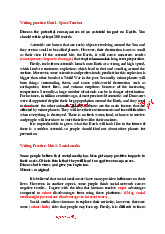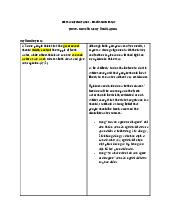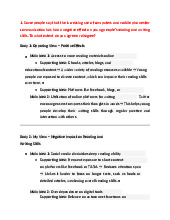







Preview text:
lOMoAR cPSD| 58137911
INTERNATIONAL UNIVERSITY DEPARTMENT OF ENGLISH
SAMPLE MID-TERM TEST Writing AE2
Task 1: Identify 6 cases of non-academic language in the text below and edit them to make an
academic text. In the box below, write the original words/phrases in the left hand column and
your editions in the right-hand column. You have an example. (30 pts)
CAN MEDICATION CURE OBESITY IN CHILDREN?
A Review of the Literature
In March 2004, U.S. Surgeon General Richard Carmona called attention to a health problem in the United
States that, until recently, we have overlooked: childhood obesity. Carmona highlighted that the
“astounding” 15% child obesity rate constitutes an “epidemic.” Since the early ‘80s, that rate has
“doubled in children and tripled in adolescents.” Now more than nine mil ion children are classified as
obese. While the traditional response to a medical epidemic is to hunt for a vaccine or a cure-all pil ,
childhood obesity has proven more elusive. Lacking success of recent initiatives suggests that
medication mightn’t be the answer for the escalating problem. In this literature review, I wil consider
whether the use of medication is a promising approach for solving the childhood obesity problem by
responding to the following questions:
1. What are the implications of childhood obesity?
2. Is medication effective at treating childhood obesity?
3. Is medication safe for children?
4. Is medication the best solution?
Understanding the limitations of medical treatments for children highlights the complexity of the
childhood obesity problem in the United States and underscores the need for physicians, advocacy
groups, and policymakers to search for other solutions.
What Are the Implications of Childhood Obesity?
Obesity can be a devastating problem from both an individual and a societal perspective. Children are
put at risk by obesity for a number of medical complications, including type 2 diabetes, hypertension,
sleep apnea, and orthopedic problems (Henry J. Kaiser Family Foundation, 2004, p. 1). In the Table 4 lOMoAR cPSD| 58137911
below, researchers Hoppin and Taveras (2004) have said that obesity is often associated with
psychological issues such as depression, anxiety, and binge eating.
Obesity also poses serious problems for a society struggling to cope with rising health care costs. The
cost of treating obesity currently totals $117 bil ion per year—a price, according to the Surgeon General,
is “second only to the cost of [treating] tobacco use” (Carmona, 2004). Of course, as the number of
children who suffer from obesity grows, long-term costs wil increase. …
Source: Diana Hacker (Boston: Bedford/St. Martin’s, 2006).
Write your answer here. No. Original word/phrase
Possible edited word/phrase 0 ‘80s 1980s 1 2 3 4 5 6
Task 2: Read the text below and create a graphic display or an outline that categorizes the points
made in the text in the next page. (20 pts)
SOLVING SCHOOL CHEATING
In my years of teaching, no student has ever admitted to a plagiary, even when questioned. The closest
admission which I get is that someone "read it over for me," or "I used my dictionary." It is a hard truth:
even when they are caught, cheaters continue to cheat. However, there is no harder task for a teacher
than to give a "0"! There are some common factors of cheating which need to be actively chal enged.
Students cheat primarily to make their lives easier. Young people, under heavy parental pressure, find
cheating a way to meet their parents' expectations. It is better to cheat than to have parents scold them
again and again. Recently in schools, the question which is often heard is, "What did you get?" Peer
pressure is another reason for student cheating. It is undesirable to say "I got a 'C'", especially in today's
competitive schools. It is possible that the most important reason for cheating is what Katie Hafner referred
to as "mental softness." It is the Internet that bears responsibility in this case. On the Internet, ideas and
words used to express ideas can be accessed easily. Why do students have to think hard if the information lOMoAR cPSD| 58137911
is substantially provided? An easy life is available to the student cheater: a life without parental nagging,
ridicule at school, or the need to work hard.
With such "softness" evident in our students, the solutions to cheating must be hard ones. Parents need
to accept their children's abilities, and to celebrate their accomplishments, no matter how small they are.
Heavy pressure, by itself, cannot make a child smarter. Students must be encouraged to make
comparisons on how much a peer has improved and on how hard that person had to work in order to
obtain a grade. For some students, a "C" is a major achievement. The hardest chal enge wil be to reshape
the Internet as a tool for creating higher order thinking, not one for avoiding difficult work. Teachers, instead
of trying to keep students away from Internet resources, must make themselves aware of the Internet's
potential for teaching. Research-based assignments (properly cited) that use the Internet should be
assigned in every classroom. In these ways, we can work on the soft attitudes and remake them into a passion for disciplined work.
Cheating is a danger to student achievements, one that needs to be chal enged vigorously. Parents,
who always want to see geniuses in their family and put frequent pressure on their children, should learn
to ease up to some extent. Students can learn to admire each other's accomplishments without resorting
to comparisons that offer little in judging a person's true worth. Furthermore, teachers can learn from their
mistakes and begin to bring the Internet into their secluded classroom worlds. If we work on this together, our success wil be assured.
The graphic display or outline:
……………………………………………………………………………………………………………………….
……………………………………………………………………………………………………………………….
……………………………………………………………………………………………………………………….
……………………………………………………………………………………………………………………….
……………………………………………………………………………………………………………………….
……………………………………………………………………………………………………………………….
……………………………………………………………………………………………………………………….
……………………………………………………………………………………………………………………….
……………………………………………………………………………………………………………………….
……………………………………………………………………………………………………………………….
……………………………………………………………………………………………………………………….
……………………………………………………………………………………………………………………….
……………………………………………………………………………………………………………………….
………………………………………………………………………………………………………………………. lOMoAR cPSD| 58137911
Task 3: Write a compare/contrast essay (about 300 words) about life in Vietnam now and a
decade ago. Pay attention to the use of academic language and a clear text structure (50 pts)
…Today, April 30, red flags are festooning the streets of Hanoi, the
Vietnamese capital, to mark the fourth decade since the U.S.-backed
South Vietnamese government surrendered to communist North
Vietnamese troops and ended the Vietnam War. But most Vietnamese are too young to
remember the day in 1975 when Saigon fell, celebrated in Hanoi as Reunification Day. For the
nearly 70 percent of the population under age 40, April 30 is just a day off from work or school.
“No one our age talks about it,” Hien, a recent university graduate from Hanoi who gave only
her first name, told me. “Most young people nowadays don’t really care about what
happened. They just want to have fun.”
Forty years after millions of Vietnamese were killed in the war, in which more than 58,000
Americans also died, locals I’ve spoken with bear little animosity toward the United States.
During the three years I spent in Hanoi, I never witnessed hostility toward Americans. When I told
Vietnamese I came from the U.S., they would smile and talk about American celebrities, like
the pre-teen who told me she loved Beyoncé or the parking-lot attendant who shook my
hand enthusiastically: “Ah, Obama!”
And unlike me, my Vietnamese contemporaries grew up in the communist country that the
war created. That country has changed dramatically over the course of their lives. When
Nguyen and Hien were children, Vietnam had just begun to integrate into the global
economy following a postwar decade of scarcity and stagnation. Since then, Vietnam has
become one of East Asia’s fastest-growing economies, and the government's staunch
communism has given way to a new pragmatism as it privatizes stateowned companies and
seeks foreign investment. A recent Pew survey found that 95 percent of the Vietnamese
people support free-market capitalism—a higher percentage than in any other country
surveyed, including the United States. As a Hanoi secretary in her 30s told me: “The war is
the past already. ... We care only about money. We don’t care about politics or history.” * * *
Students in Hanoi learn about the American War for the first time in elementary school,
taking class trips to the capital’s Ho Chi Minh
Mausoleum—which houses the embalmed remains of the communist leader who led the
war for independence against the French—and Military History Museum. In the following
years, they study the conflict in the context of the country’s history of fighting colonial
powers, from its 10thcentury rebellion against China to its war against France beginning in
the 1940s. “Each year, we learn the same thing in more detail. America started the war to
help France get Vietnam back,” university student Luong Tuan Bach, 19, told me from a
bench beside Hanoi’s Hoan Kiem Lake, where he sells Coca-Cola and iced tea to passing
tourists to earn spending money. lOMoAR cPSD| 58137911
Luong said he felt these lessons were important, and cited a well-known Ho Chi Minh poem:
“Our people have to know our history.” But other young people I spoke with complained that
history classes are too dry and tedious to make a lasting impression. “We started learning
about the war in sixth grade, but I don't remember much. History is too boring, just texts
after texts,” Nguyen Thi Huong, the university student, said.
Those texts, which, as Hien recalled, depict a “hard but glorious” struggle to defeat the
American invaders, present the official Vietnamese view. “We learned that even though the
U.S. army was really mighty and their weapons were really modern, the Vietnamese country
united and stood up for our freedom,” Thuy, a university student in Hanoi, told me.
This attitude separates millennials from their parents and grandparents. “Older people might
put communism on a pedestal, but for us it means very little. Young people care more about
their own dreams, their own careers,” Nguyen, the university student, said.
Luong, the soda vendor by the lake, hopes “to become a successful businessman” in the
construction industry. Had he started his career 20 years ago, he might have strived to work
for a government-run company. But state-owned businesses—once the cornerstone of Vietnam’s economy
—have declined in recent years, weighed down by bad debt. Between 2000 and 2013, the
number of state-run enterprises halved. Many have been privatized as part of the
government’s ongoing economic-
restructuring efforts, although officials still often refer to this process as “equitization” rather than “privatization.”
Government agencies are also drawing fewer young employees. “Privatesector jobs pay a lot
more than government jobs,” Trang, 28, explained to me. An event organizer for an
international company, Trang never considered following in the footsteps of her parents,
former government employees and Communist Party members who gave up both their jobs
and political memberships when she was young. “My mom has her own grocery shop at
home, so she doesn’t care about policy or the party,” she said.
Like Trang’s mother, many Vietnamese have taken advantage of 1980sera reforms that
allowed them to open their own businesses. Today, Hanoi teems with entrepreneurial
ambition. Vendors fill the sidewalks, selling everything from pedicures to pet goldfish.
Families have converted parts of their houses to cafes, hair salons, and PC gaming parlors,
imparting this same enterprising mindset in their children. Ray Greiner, an American war
veteran who returned to Vietnam in 2011 to teach English, said most of his students wanted
to own their own businesses. “That's a huge difference from the young people I know in the
U.S.—and a huge difference from my generation as well,” Greiner told me.
As the growing middle class flocks to new malls like the palatial Vincom Royal City, a few
Vietnamese entrepreneurs have reaped enormous profits. They include Pham Nhat Vuong,
the country’s first billionaire and CEO of the company behind Royal City, and Dang Le Nguyen
Vu, who founded Trung Nguyen Coffee and whose wealth, estimated at $100 million,
inspired the nickname “Coffee King.” Nearly 400 people have made millions investing in the lOMoAR cPSD| 58137911
stock market, according to a local newspaper, some of them born after reunification.
American fast-food franchises like McDonald’s and Starbucks opened their first branches in
Vietnam in the past couple of years, and have been interpreted by some as a sign of the
triumph of American-style capitalism.
But this blatant embrace of the market economy does not mean that
Vietnamese feel equally strongly about political reform. Unlike in Hong Kong, support for
capitalism has not translated into a visible prodemocracy social movement. Vietnam remains
a one-party state. While government sources report extremely— perhaps implausibly—high
turnout for National Assembly elections, none of the young people I spoke with had much faith that voting matters.
The lack of a pro-democracy movement in part reflects the realization that advocating radical
political change would be risky. Few want to share the fate of the bloggers arrested for
criticizing the government, although the Internet has made it more difficult to repress
dissent. “In my time, just speaking out one time could put you in jail,” said a Hanoi man who
was imprisoned in the 1970s for starting an organization to protest the American War. He
asked that his name not be used. “Now, it’s easier for young people to get information and
speak out their opinion. ... Maybe one or two times is OK, they just warn you. But if you do it
over and over and make it seem like you’re trying to gather people, they can still put you in jail.”
But more than that, young Vietnamese I’ve met see the potential for producing social change
outside the formal political system. “We have activities to raise awareness about the
environment and underprivileged people,” Trang told me. “But we don’t care about the
government or any political stuff. The government controls everything.”
While Trang’s generation is not rebelling against Communist Party leadership, its members
are finding ways to communicate their views to the government. Young people have started
using social media to express their concerns about development issues, such as a plan to
build a cable car through the world’s largest cave. And sometimes the government is even
responsive. A Facebook campaign to stop Hanoi from chopping down thousands of old trees
drew 20,000 supporters in one day, motivating city authorities to reverse the decision.
“We are the new generation, we are the change,” blogger Duong Vu Hoang Anh told me
during the campaign to stop the cable car, which seems to have had some success so far.
“Vietnamese youth have participated in this issue like nothing else before. We realize that
this decision should be ours.”
…………………………………………………………………………………………………………………….
SAMPLE MID-TERM TEST AE2 WRITING – ANSWER KEY Task 1: 30 points lOMoAR cPSD| 58137911
a. Question type: Editing a non-academic text (6 cases of non-academic language)
b. Objective: To assess students’ ability to write proper language for research papers. c. Scoring rubric:
Indicators of academic language:
Indicators of non-academic language: Ful forms Short forms Formal connectors Informal connectors
Use of nominal groups (verbs made into nouns) Use of pronouns Use of the passive voice Use of the active voice Concise vocabulary Informal vocabulary
Objective and impersonal point of view
Subjective and personal point of view
Suggestion: 5 pts for each acceptable edition. 0 is given as an example. No. Original word/phrase
Possible edited word/phrase 0 ‘80s 1980s 1 we have have been 2 Lacking success The lack of success 3 mightn’t might not 4
In this literature review, I wil consider
This literature review considers 5 Said noted, indicated 6 Of course Obviously/ It is obvious that Task 2: 20 points
a. Question type: Identifying text structure
b. Objective: To assess students’ ability to understand a text and to elicit the organizational structure of that text. c. Scoring rubric: - Category (main idea) -
Sub-categories (which develop the main idea) -
Major details (which support the sub-categories) Possible text structure:
Category: There are some common factors of cheating which need to be actively chal enged.
Sub- category 1: Reasons for cheating - Parental pressure - Peer pressure - Availability of the Internet lOMoAR cPSD| 58137911
Sub-category 2: Solutions to cheating -
Parents accept and motivate their children -
Students recognize their peers’ improvement and effort -
Teachers use the Internet properly Task 3: 50 points
a. Question type: Writing an academic Compare/contrast essay
b. Objective: To assess students’ ability to write an academic essay with elements of research language c. Scoring rubric: Content 15
Al main points relevant to topic Essay question fully answers Organization 15
Topic and purpose of the essay discussed in the introduction
Each main point discussed in a paragraph
Al main points summarized and rephrased in the conclusion Coherence 10
Paragraphs ordered in a systematic manner based on, for example, importance, priority, etc.
Compare/contrast transitions are properly used. Style and Tone 10
Formal writing with full forms Polite writing Academic vocabulary



